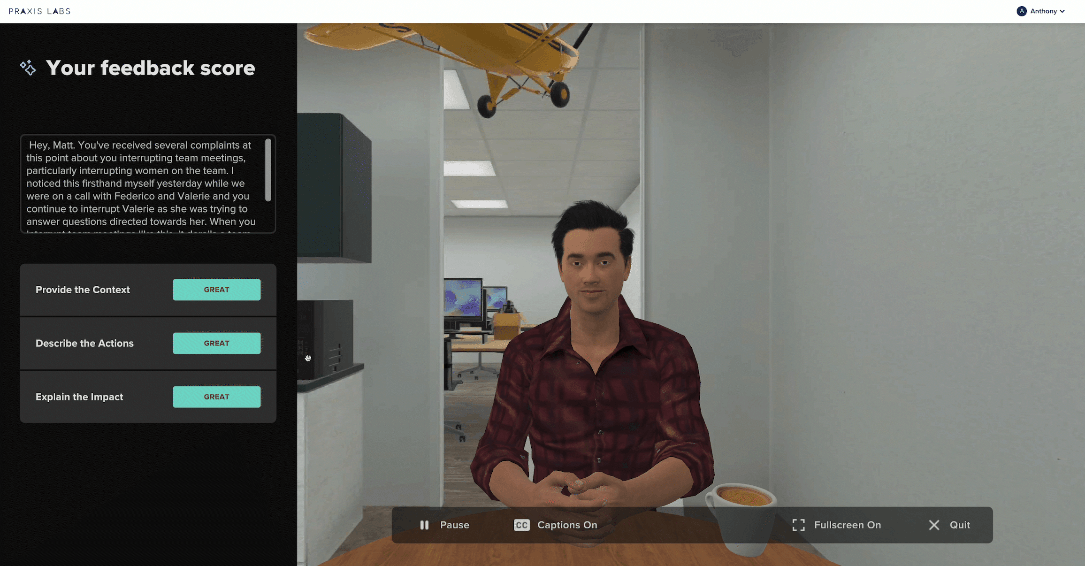- Talent Development
Feedback in the Modern Workplace: Challenges, Pitfalls, and Solutions
A robust performance management system based on feedback is vital for an employee’s professional growth and development. But when it comes down to the particulars of how performance feedback in the workplace should be given, leaders have long been divided on which approach — standardized or continuous — is most effective.
Years ago, organizational experts advocated to shift away from the annual review model to evaluate performance and determine pay. The once-yearly “standardized” review process was found to be ineffective at inspiring better performance in employees, with only 14% of employees in 2017 strongly agreeing that traditional performance reviews inspired them to improve, according to a Gallup survey. Additionally, they were found to be unnecessarily costly and time-consuming, with some companies losing as much as $35 million a year in working hours just so employees could participate in them.
As a result, leading companies such as Accenture, Deloitte, Microsoft, and General Electric elected to do away with annual reviews altogether in favor of a “Continuous Performance Management” approach. Intending to reduce turnover and increase engagement, this approach involves planning (setting goals), checking in (through coaching), and reviewing (giving transparent and frequent feedback).
Founded on the idea that the most impactful feedback is given in real-time, specific, actionable, and meaningful. However, this shift is not without its set of challenges and risks of disengaging employees. If handled inexpertly, it can make employees feel “hounded” or micromanaged, damaging morale.
So how do we reconcile these different approaches for the best result possible? Having researched the subject of performance management extensively, our in-house Curriculum team has found that the “Context, Action, Impact” approach to continuous feedback has the most positive impact. Organizations should invest in training, communication tools, and a growth-oriented culture to successfully implement the CAI model.
Putting the Context-Action-Impact framework to work
What does the CAI model look like in action? While this model centers the classic manager-report feedback session, it also often appears as informal peer-to-peer debriefs. For example, you feel frustrated with a colleague who repeatedly interrupts you during a presentation and want to bring it to their attention. How would you proceed?
Let’s dive in.
1. Context is everything
The first step to building a great feedback model is giving detailed context — something often lost in an annual review assessment. Instead of offering a “broad-brush” overview that fails to capture the nuance of where an employee excels and has room to grow, aim for specificity and context whenever possible.
For example, in the scenario given above you might start by pulling your colleague aside and respectfully saying: “During our team meeting yesterday afternoon, when we were discussing our project timeline, you repeatedly interrupted my presentation.”
2. Hone in on the action that was disruptive or unproductive
Next, it’s important to call out the specific behavior that you found disrespectful so there’s no room for confusion. For example: “In my presentation, you and Martina were whispering to each other throughout.” This prompts the person to recognize how something seemingly minor, which they may have thought went unnoticed, was in fact disruptive.
3. Be clear about the action’s impact on others
To demonstrate that their behavior has consequences, be specific about how it made you or someone else feel. For example: “I felt distracted, leading to difficulty answering questions.” Connecting their behavior to a negative outcome for someone else should elicit an empathetic response on their part. Thus, reinforcing that this action should not to be repeated. However, notice how there is no blaming, shaming, or broad characterizing involved. Simply a recount of the incident and how it impacted you. This kind of specificity motivates improved future actions, rather than resentment, on the part of the addressee.
Calling out positive as well as negative actions
This three-pronged approach has proven to assist people in course-correcting. It’s also highly relevant in positive reinforcement scenarios and must be exercised in positive scenarios in equal measure to negative ones. For example, if an employee appears to be honing a skill to the benefit of your team, you might follow the CAI model by giving them the following feedback:
Context: “Your persuasive speaking skills have really improved since last quarter”
Action: “The clear, evocative way you communicated the unique value of our offering was instrumental in getting the client’s buy-in.”
Impact: “I felt energized by the way you told our story, and the client seemed to respond very positively!”
Bringing DEI and feedback together with open-ended questions
As learning professionals transition from traditional performance reviews and methods of giving feedback to the Context – Action – Impact model, it’s critical to consider the role that DEI plays in the feedback process.
Incorporating DEI into feedback means recognizing that our backgrounds, experiences, and perspectives heavily inform the ways people prefer to give and receive feedback. The risk of giving feedback poorly can result in hostile or toxic work environments. People will have different views on what’s appropriate or crossing the line. Factors such as age, race, gender, sexuality, and other identities inform those differences.
To better understand the root causes of disagreements or conflicts, it’s important to ask open-ended questions. This can help managers better understand how identity informs peoples attitudes and behaviors in the workplace. When conflicts arise, this helps managers get to the root of a problem, rather than applying a one-size-fits-all approach.
Using open-ended questions alongside the Context – Action – Impact framework is one way for managers and team leaders to root their feedback in specificity while striking a balance between constructive criticism and positive reinforcement. It also doesn’t hurt to simply ask your team members how and when they prefer to receive feedback.
A strategic approach to feedback in the workplace
The transition from traditional performance reviews to the CAI model marks a significant step towards improving employee engagement and productivity. However, it is not without its challenges, especially regarding timing, specificity, and balancing constructive criticism. Organizations should invest in training, communication tools, and a growth-oriented culture to successfully implement the CAI model. A more robust performance management system will result in catalyzing a culture of continuous improvement that is vital for success in today’s dynamic work environment.









